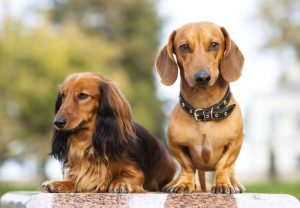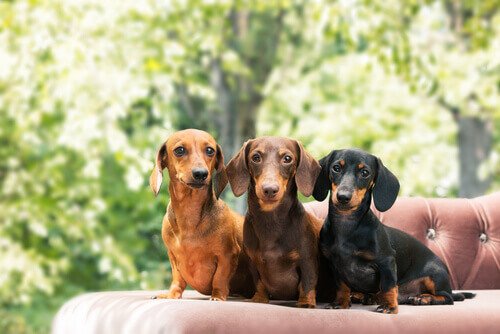Dogs in FCI Group 4: The Dachshunds

The FCI (La Fédération Cynologique Internationale) is responsible for setting standards for each dog breed and classifying them into groups according to their characteristics. In this article, we’ll tell you a bit about which dogs belong in group 4: the Dachshunds.
Dog Breeds in Group 4
This group consists of a single category, the Dachshund, or as they’re more popularly known as, “sausage dogs,” which are then separated into three types according to service and size.

This breed owes its particular physiognomy to a genetic mutation called Bassetism (which is also present in the Basset Hound, for example). According to their weight, Dachshunds can be:
- Standard (9 to 11 kg)
- Miniature (4.5 to 6 kg)
- Kaninchen or “Rabbit” (less than 4.5 kg)
Dachshunds are also classified by their fur types:
- Wire-haired (gray)
- Smooth-haired (black, orange, brown, harlequin)
- Long-haired (same colors as the smooth-haired)
History and Characteristics of Dachshunds
Group 4 dogs came from Germany at the end of the 19th century. In 1888, the first document on the physical characteristics of this breed was written. Dachshunds then gained in popular because of royalty. For example, Queen Victoria was always a big fan.
Although Dachshunds are indeed “burrowing dogs”, the FCI decided to create a group solely for this breed because it does not resemble any other dog breed. In terms of character and build, they are not even like Basset Hounds.
As for their so-called “sausage dog” appearance, it is quite peculiar and distinctive. Dachshunds have a long body, a long tail, a protruding snout, short legs, black nails and big, droopy ears.
Hunters would train them as trackers in fields to search for rabbits and other animals that live in burrows. They are very brave and will not hesitate in the face of animals bigger than them, even a boar or a larger dog.
Dachshunds: Behavior and Training
Dachshunds are usually somewhat stubborn dogs, but, nevertheless, they can be trained. Owners often spoil group 4 dogs because of their size, though with proper training they can become loyal followers.
The breed is very intelligent and can learn quite fast. It just takes a little patience and, above all, perseverance. Dachshunds make loving, protective and playful pets, and are ideal for homes with children (on occasion, though, Dachshunds can be a little rough with kids). Despite having an excellent nose and the ability to perform hound tasks, they are not Pointers or Terriers, nor are they hunting dogs.

Dachshunds and Health
One of the main health problems that this breed faces is related to their spine, which is longer than normal, and to their ribs, which are usually short.
A herniated disc or other vertebral problem could be serious if a Dachshund is overweight. To prevent ailments in the future, it’s best if Dachshunds don’t have to go up and down stairs on a daily basis or jump around too much.
With proper physical activity, they should not have problems. Group 4 dogs are quite agile and have exceptional reflexes, but don’t run very fast due to their short legs.
As for their hygiene, regular brushing is essential to remove excess fur. Dry shampoo is a good idea, but if you opt for a bath, always dry your dog off extremely well afterwards.
Due to their small stature and good temperament, they are suitable for small apartments, as well as houses with gardens or yards. Dachshunds love home life and are excellent guardians and protectors of their families.
The FCI (La Fédération Cynologique Internationale) is responsible for setting standards for each dog breed and classifying them into groups according to their characteristics. In this article, we’ll tell you a bit about which dogs belong in group 4: the Dachshunds.
Dog Breeds in Group 4
This group consists of a single category, the Dachshund, or as they’re more popularly known as, “sausage dogs,” which are then separated into three types according to service and size.

This breed owes its particular physiognomy to a genetic mutation called Bassetism (which is also present in the Basset Hound, for example). According to their weight, Dachshunds can be:
- Standard (9 to 11 kg)
- Miniature (4.5 to 6 kg)
- Kaninchen or “Rabbit” (less than 4.5 kg)
Dachshunds are also classified by their fur types:
- Wire-haired (gray)
- Smooth-haired (black, orange, brown, harlequin)
- Long-haired (same colors as the smooth-haired)
History and Characteristics of Dachshunds
Group 4 dogs came from Germany at the end of the 19th century. In 1888, the first document on the physical characteristics of this breed was written. Dachshunds then gained in popular because of royalty. For example, Queen Victoria was always a big fan.
Although Dachshunds are indeed “burrowing dogs”, the FCI decided to create a group solely for this breed because it does not resemble any other dog breed. In terms of character and build, they are not even like Basset Hounds.
As for their so-called “sausage dog” appearance, it is quite peculiar and distinctive. Dachshunds have a long body, a long tail, a protruding snout, short legs, black nails and big, droopy ears.
Hunters would train them as trackers in fields to search for rabbits and other animals that live in burrows. They are very brave and will not hesitate in the face of animals bigger than them, even a boar or a larger dog.
Dachshunds: Behavior and Training
Dachshunds are usually somewhat stubborn dogs, but, nevertheless, they can be trained. Owners often spoil group 4 dogs because of their size, though with proper training they can become loyal followers.
The breed is very intelligent and can learn quite fast. It just takes a little patience and, above all, perseverance. Dachshunds make loving, protective and playful pets, and are ideal for homes with children (on occasion, though, Dachshunds can be a little rough with kids). Despite having an excellent nose and the ability to perform hound tasks, they are not Pointers or Terriers, nor are they hunting dogs.

Dachshunds and Health
One of the main health problems that this breed faces is related to their spine, which is longer than normal, and to their ribs, which are usually short.
A herniated disc or other vertebral problem could be serious if a Dachshund is overweight. To prevent ailments in the future, it’s best if Dachshunds don’t have to go up and down stairs on a daily basis or jump around too much.
With proper physical activity, they should not have problems. Group 4 dogs are quite agile and have exceptional reflexes, but don’t run very fast due to their short legs.
As for their hygiene, regular brushing is essential to remove excess fur. Dry shampoo is a good idea, but if you opt for a bath, always dry your dog off extremely well afterwards.
Due to their small stature and good temperament, they are suitable for small apartments, as well as houses with gardens or yards. Dachshunds love home life and are excellent guardians and protectors of their families.
This text is provided for informational purposes only and does not replace consultation with a professional. If in doubt, consult your specialist.








